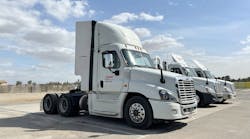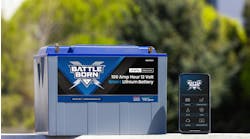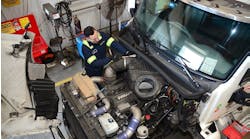TruckWings prove their worth, durability in passing major milestone
The American Transportation Research Institute recently revealed in its 18th annual Top Industry Issues report that fuel prices were the trucking industry’s top concern. The issue’s highest previous rank was 8th place in 2013. Price volatility has been affected by the war in Ukraine and a global push toward renewable energy, among other factors.
Prices started to come down after record highs, but diesel prices have risen $0.50 from the beginning to middle of October, according to the U.S. Energy Information Administration, and while fleets are at the mercy of much larger geopolitical forces on that front, they can hedge against fuel volatility with investment in fuel efficient practices and equipment.
NACFE identified 10 ways to do this, and at the top of the list was trailer aerodynamics. More fleets are appearing to understand this, as TruckLabs announced its automatic highway aero solution, TruckWings, has crested 500 million miles of use. Affixed to the back of a cab, the system uses retractable flaps to close the gap between the tractor and trailer. This happens above 52 mph without driver intervention, and allows air a linear path to the back of the truck, as opposed to creating resistance near the fifth wheel. Two-thirds of a truck’s fuel usage on highways is to overcome aerodynamic drag, according to TruckLabs.
Product info: TruckLabs TruckWings (Gen 3)
The company also said that customers using the system will see a 3-6% fuel savings, and 5.5% range extension for electric trucks.
“Five hundred million miles is a huge milestone for us. It demonstrates our sustained commitment to delivering durable, double-win results on both carbon emissions and dollars. Our telematics technology tracks every mile driven through harsh Canadian winters and asphalt-melting Arizona summers. It’s a huge credit to the team’s engineering work to hit this milestone so quickly,” TruckLabs founder and CEO Daniel Burrows said. “TruckWings help fleets reduce fuel costs and emissions today and will improve the range of electric trucks in the future.”
Over all those miles of asphalt, TruckWings has gleaned many other insights into the nature of truck aerodynamics.
“One of our biggest learnings is that the larger the gap between the tractor and trailer the greater the opportunity for fuel and carbon savings,” said Andrew Kelly, VP of product for TruckWings. “In particular, we’ve seen the strongest savings on day cabs and alternative fuel tractors with long wheelbases.
“The cab length of a day cab does a poor job of managing the airflow over a short distance before it separates from the edge of the cab fairings,” Kelly continued. “This means a significant amount of air rushes into the tractor-trailer gap, increasing drag. When deployed, TruckWings reduce the drag between the cab fairings and the trailer over a gap shorter than any aerodynamic sleeper on the market. TruckWings gives your day cab the aerodynamics of a sleeper at a fraction of the cost.”
“With respect to gap closures, savings can be very big for day cab regional haul operations where the gap is larger for maneuverability reasons,” relayed NACFE executive director Mike Roeth to Fleet Maintenance. “Economy gains of 5-7% are possible for tractors.”
For sleeper cabs, “significant ROI savings” will be realized for trucks exceeding 200,000 miles per year, Kelly said. “Obviously with diesel prices hovering around $5/gallon, our customers are realizing higher ROI than ever before,” he added.
And the savings will hold true even as fleets transition to trucks powered by electricity, hydrogen, propane, or CNG.
“Aerodynamics is crucial to all of the alternative powered trucks,” NACFE executive director Mike Roeth relayed to Fleet Maintenance. “TruckWings saves big dollars on diesel fuel costs, but also are crucial to range anxiety. A 5% fuel savings could extend the range of a 400-mile truck by 20 miles. Put that together with tractor aero, trailer aero, lower speeds and some driver training and incentives and that can grow to over 20%. That is huge.”
Like any additional component on a truck’s exterior, they create additional considerations for the driver and maintenance department, but TruckWings, now in their third iteration, do not seem to hinder those operations.
“One area of concern had been durability, but the devices are proving robust so far,” Roeth said.
According to Kelly, “annual maintenance is minimal and includes oiling the pneumatic actuators and completing a bushing service.”
TruckLabs offers part kits with all the parts required to replace the bushings.
Fleet case study
Ryder performed an extensive 12-week study over 2.7 million miles to validate TruckWings efficacy in the Southwest. The result was 4.1 % improved mpg, with no downtime reported due to TruckWings mechanical failures.
The logistics company first sent six weeks gathering baseline data with 60 identical Class 8 diesel trucks without TruckWings. Then the TruckWings system was installed on 30 of these trucks for the next six weeks.
TruckLabs monitored telematics data to check when the aero device was deployed, and Ryder provided the fuel usage data. TruckWings were deployed for around 560,000 miles total. The expected total operational deployment rate over all miles driven set by TruckLabs was 70%, and the Ryder trucks equipped with TruckWings actually used them 86% of the time, wit 97% at highway speeds.
“Ryder takes new product testing seriously. The wings ran without any issues and the fuel economy results came in above what we were promised,” said Mike Plasencia, group director of RyderVentures and new product strategy at Ryder System. “It’s been a great experience so far.”





